
Santa Clara Pueblo "Singing Water Village", also known as "Village of Wild Roses" is a census-designated place (CDP) in Rio Arriba County, New Mexico, United States and a federally recognized tribe of Native American Pueblo people.

Maria Poveka Montoya Martinez was a Puebloan artist who created internationally known pottery. Martinez, her husband Julian, and other family members, including her son Popovi Da, examined traditional Pueblo pottery styles and techniques to create pieces which reflect the Pueblo people's legacy of fine artwork and crafts. The works of Maria Martinez, and especially her black ware pottery, are in the collections of many museums, including the Smithsonian, the Metropolitan Museum of Art, the Denver Art Museum, and more. The Penn Museum in Philadelphia holds eight vessels – three plates and five jars – signed either "Marie" or "Marie & Julian".

Lucy Martin Lewis was a Native American potter from Acoma Pueblo, New Mexico. She is known for her black-on-white decorative ceramics made using traditional techniques.
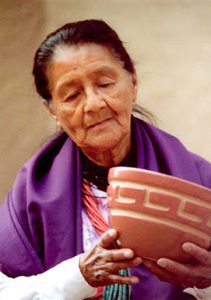
Maria Margarita "Margaret" Tafoya was the matriarch of Santa Clara Pueblo potters. She was a recipient of a 1984 National Heritage Fellowship awarded by the National Endowment for the Arts, which is the United States government's highest honor in the folk and traditional arts.
Anita Louise Suazo is a Native American potter from Santa Clara Pueblo, New Mexico, United States.
Arthur and Hilda Coriz were Native American husband and wife potters from Santo Domingo Pueblo, New Mexico, United States. They signed their pottery as "Arthur and Hilda Coriz."
Nathan Youngblood is a Native American potter from Santa Clara Pueblo, New Mexico, United States.
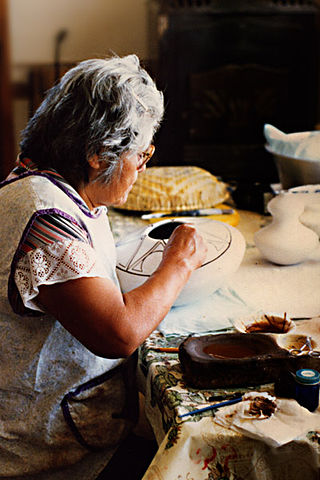
Helen Naha (1922–1993) was the matriarch in a family of well known Hopi-Tewa potters.
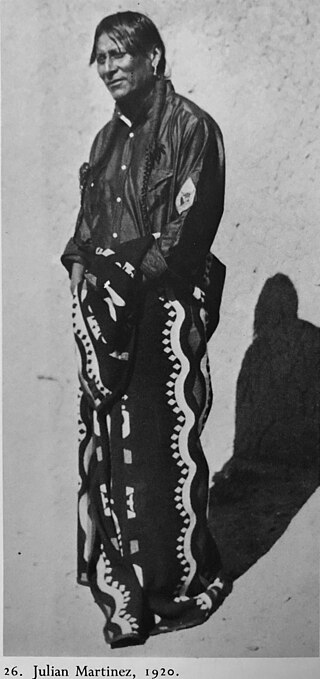
Julián Martínez, also known as Pocano (1879–1943), was a San Ildefonso Pueblo potter, painter, and the patriarch of a family of Native American ceramic artists in the United States.

Roxanne Swentzell is a Santa Clara Tewa Native American sculptor, ceramic artist, Indigenous food activist, and gallerist. Her artworks are in major public collections and she has won numerous awards.

Art of the American Southwest is the visual arts of the Southwestern United States. This region encompasses Arizona, New Mexico, and parts of California, Colorado, Nevada, Texas, and Utah. These arts include architecture, ceramics, drawing, filmmaking, painting, photography, sculpture, printmaking, and other media, ranging from the ancient past to the contemporary arts of the present day.
Jody Naranjo is a contemporary Tewa pottery maker from the Santa Clara Pueblo, New Mexico in the United States. She comes from a family of traditional Tewa potters. She learned the craft of pottery from her mother, Dolly Naranjo, and other female relatives. She attended the Institute of American Indian Arts. Naranjo was selling her artwork at age fifteen at the New Mexico History Museum. Her style is identifiable and showcases her keen sense of humour. Jody has 3 daughters and maintains her connections to her heritage and friends. She is represented by Blue Rain Gallery in Santa Fe.
Jody Folwell-Turipa is a Puebloan potter and artist.
Tammy Garcia is a Santa Clara Pueblo sculptor and ceramic artist. Garcia translates Pueblo pottery forms and iconography into sculptures in bronze and other media.
Grace Medicine Flower is a potter, best known for her intricately carved miniature redware and blackware.

Angela Tafoya Baca was a Native American artist who was known for her redware and blackware pottery, especially melon bowls and bowls featuring a bear paw design. She had one of the longest careers of the potters in Santa Clara Pueblo in New Mexico. She was a member of the Tewa and a resident of Santa Clara Pueblo.
Helen Shupla (1928-1985) was an American potter from Santa Clara Pueblo, New Mexico.

Black-on-black ware is a 20th- and 21st-century pottery tradition developed by Puebloan Native American ceramic artists in Northern New Mexico. Traditional reduction-fired blackware has been made for centuries by Pueblo artists and other artists around the world. Pueblo black-on-black ware of the past century is produced with a smooth surface, with the designs applied through selective burnishing or the application of refractory slip. Another style involves carving or incising designs and selectively polishing the raised areas. For generations several families from Kha'po Owingeh and P'ohwhóge Owingeh pueblos have been making black-on-black ware with the techniques passed down from matriarch potters. Artists from other pueblos have also produced black-on-black ware. Several contemporary artists have created works honoring the pottery of their ancestors.
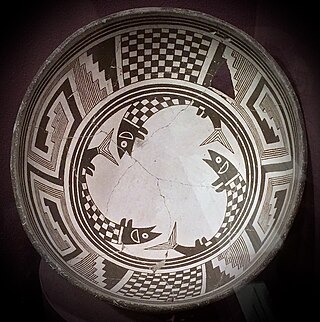
Pueblo pottery are ceramic objects made by the indigenous Pueblo people and their antecedents, the Ancestral Puebloans and Mogollon cultures in the Southwestern United States and Northern Mexico. For centuries, pottery has been central to pueblo life as a feature of ceremonial and utilitarian usage. The clay is locally sourced, most frequently handmade, and fired traditionally in an earthen pit. These items take the form of storage jars, canteens, serving bowls, seed jars, and ladles. Some utility wares were undecorated except from simple corrugations or marks made with a stick or fingernail, however many examples for centuries were painted with abstract or representational motifs. Some pueblos made effigy vessels, fetishes or figurines. During modern times, pueblo pottery was produced specifically as an art form to serve an economic function. This role is not dissimilar to prehistoric times when pottery was traded throughout the Southwest, and in historic times after contact with the Spanish colonialists.
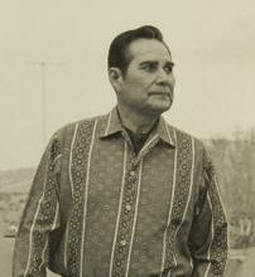
Popovi Da (1923–1971) was a San Ildefonso Pueblo Native American potter. He was also known as Tony Martinez. As an artist he worked as a collaborative team with his mother, the noted Tewa potter, Maria Martínez, and also independently on his own works. He served six terms as Governor of San Ildefonso Pueblo beginning in 1952.












